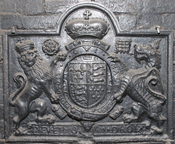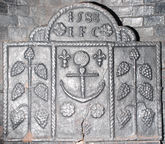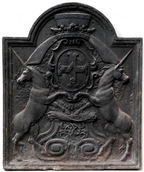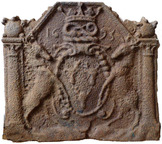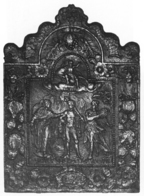-
349
Description: Arched rectangular shape; ovolo-moulded edging; Tudor royal shield, garter, crown, motto and supporters (crowned lion and dragon); Tudor rose to right of lion’s head, portcullis to left of dragon’s head; temp. Elizabeth I.
Notes: Three versions of this fireback are known, with differing edging and one without the rose and portcullis.
Copies of this fireback are known.
Inscription: [Garter] HONI SOIT QVI MAL Y PENSE / [motto] DIEV ET MON DROIT.
Arms: Tudor royal
- Decoration tags:
- rectangular with round arch (shape)
- ovolo (edging)
- whole carved pattern
- heraldic
- armorial
- royal
- text
Manufactured: in the late-16th century possibly in the Weald area of England.
Current location: Bramshill House, Bramshill, Hampshire, England.
Citation: Baines, J. M., 1958, Wealden Firebacks (Hastings Museum).
- Attached to series:
- Tudor royal armorial firebacks
-
621
Description: Rectangular; ovolo moulded edging (top and sides); central shield, crest and mantling of the Fuller family. The date, of which the 1 is not visible, is split between the top corners of the shield and about two-thirds of the way down.
Notes: A carved armorial on a plain, edged base board; the arms of the Fullers of Brightling Park, Sussex, are: Argent, three bars and a canton gules; the crest; Out of a ducal coronet Or, a lion’s head argent. The Fullers were iron masters and gun founders in the first half of the 18th century, operating Heathfield furnace, where it is likely that this fireback was cast.
Copies of this fireback are known.
Inscription: [1] 7 / 4 7
Arms: Fuller, of Brightling, Sussex
- Decoration tags:
- rectangular (shape)
- ovolo (edging)
- carved pattern panels
- heraldic
- armorial
- text
Manufactured: in 1747 probably at Heathfield Furnace in the Weald area of England.
Current location: in private hands, Butleigh, Somerset, England.
- Attached to series:
- Ironmasters armorial series
- Personal armorial firebacks
-
857
Description: Rectangular with detached pediment linked by S-curves, protruding from each of which is a small scroll; cavetto-moulded edging (top and sides); quartered shield with helm, crest and mantling; initials in top corners.
Notes: The arms are of Sir Julius Caesar (1558-1636), judge and politician, Chancellor of the Exchequer 1606-13. Blazon: Quarterly, 1st and 4th, Gules, three roses argent, on a chief of the second three roses of the first (Caesar); 2nd, argent, two bars sable, on a chief of the second three swans of the first (?Martin); 3rd, gules, three crescents argent (Peryent/Perin). Crest: a dolphin embowed in the sea vert. This example has the additional initials, TC. The style of the carving is the same as on two other firebacks in the same county.
Copies of this fireback are known.
Inscription: T C
Arms: Caesar
- Decoration tags:
- rectangular with detached pediment (shape)
- cavetto (edging)
- whole carved pattern
- individual letters
- planklines
- armorial
- text
Manufactured: in the early-17th century possibly in the Herefordshire area of England.
Current location: Croft Castle, Yarpole, Herefordshire, England.
Museum number: 537532 (part of the National Trust museum group)
- Attached to series:
- Personal armorial firebacks
- Loop edged firebacks
- Herefordshire armorial series
-
281
Description: This fireback comprises at least four separate elements: the rectangular central panel has an anchor with coiled rope between two fleurs de lys, below which are two roses; the two rectangular side panels each comprise a vertical stem with six grape bunches surmounted by a smaller bunch; above, a semicircular arch contains the initials between two roses as in the central panel, with the date above; where the arch meets the central panel there is an arc across each corner; the top and sides panels are edged with simulated twisted rope.
Notes: A variant of the well-known ‘Armada’ fireback. Copies of this fireback were advertised in Bratt Colbran Ltd.'s (London) catalogue in the early-20th century.
Copies of this fireback are known.
Inscription: 1588 / IFC
- Decoration tags:
- rectangular with round arch (shape)
- simulated rope (edging)
- carved pattern panels
- text
- plants
- objects
Manufactured: in 1588 in the Weald area of England.
Current location: Chequers, Ellesborough, Buckinghamshire, England.
- Attached to series:
- Armada series
-
1045
Description: Arched rectangular shape; ovolo-moulded edging; top centre, oval shield of arms within a cartouche, supported by two unicorns rampant reguardant, their hooves resting on a scrolled compartment; behind the shield is the cape of the Président à mortier of the Parliament; above the shield, a velvet cap or mortar board of office within a coronet.
Notes: Blazon: azure, on a maltese cross argent a chevron gules between two mullets sable, and in base a rose gules. Louis-Michel Lepeletier, Marquis de Saint-Fargeau (1760-93) was a French parliamentarian. Having voted for the execution of Louis XVI Lepeletier was assassinated by a former guard of the king. The fireback dates from 1789 or later when Lepeletier was elected Président à mortier.
Arms: Louis-Michel Lepeletier, Marquis de Saint-Fargeau
- Decoration tags:
- rectangular with round arch (shape)
- ovolo (edging)
- whole carved pattern
- heraldic
- armorial
Manufactured: in the late-18th century in France.
Current location: 120 Rue de Rosiers, Saint Ouen, Seine-Saint-Denis, France.
- Attached to series:
- Foreign armorial firebacks
-
818
Description: Quasi-arched rectangular shape; on a ground, an armorial achievement comprising a central cartouche on which is an oval shield bearing the arms of the Cavendish family, with graduated bead edging; supporters, two stags rampant; above the cartouche, on a wreath a coiled snake crest surmounted by an earl’s coronet; the date split either side of the crest; to each side, a column with foliate capital supporting a three-sided arch with ovolo-moulded edging, on each shoulder of which is a flaming orb.
Notes: The arms are those of the Earls of Devonshire. However, the date relates to William Cavendish (1640-1707), previously 4th Earl and created 1st Duke of Devonshire in 1694. An earlier casting (no. 246) has a date of 1657, the second pair of numerals having been changed. Christie's auction 3 Dec 2014 lot 15 (dated incorrectly as 1693) (£1,875).
Inscription: 1695
Arms: William Cavendish, 1st Duke of Devonshire, as 4th Earl of Devonshire
- Decoration tags:
- rectangular with three-facetted arch (shape)
- complex individual (edging)
- whole carved pattern
- individual numbers
- armorial
- text
Manufactured: in 1695 in England.
Current location: not known.
- Attached to series:
- Personal armorial firebacks
- Cavendish arms series
-
1063
Description: Composite of three elements; central panel has a complex ‘knot’ pattern with a fillet edge; side panel, repeated on either side of the central panel, contains a vase of flowers, possibly stylised thistles, within an arched frame and fillet edge; arched panel above, also with fillet edge, contains the date and inscription; the spandrels of the side panels, and the arched top panel, contain a series of circular motifs comprising concentric rings deepening towards the centre.
Notes: ‘Knot’ patterns were popular in gardens of the period. The garden theme is continued with the side panels. An example of the same design, noted at Linchmere, West Sussex, is a different casting, the top panel with the date and initials being slightly askew. From a photograph in the Victoria and Albert Museum, London; photographed at Mapesbury House, Willesden in 1904.
Copies of this fireback are known.
Inscription: 1598 / IM IB
- Decoration tags:
- rectangular with round arch (shape)
- astragal (edging)
- carved pattern panels
- text
- plants
- objects
Manufactured: in 1598 in the Weald area of England.
Current location: not known.
Museum number: E.4376-2000 (part of the Victoria & Albert Museum museum group)
- Attached to series:
- Armada series
- Garden design types
-
1273
Description: Arched rectangular central panel with bead on fillet edging, pictorial scene of Hercules standing, right arm akimbo and left hand holding a club that rests on his shoulder; to his right the allegorical female figure of Virtue, clothed and resting her left hand on Hercules's right shoulder; to his left the female allegorical figure of Volupta, the pair symbolising the 'crossroads' where Hercules has to decide which path in life to take; below them the text VIRTUS HERCULES VOLUPTA; above, seated above clouds, Jupiter surveys the scene, the word IVPITER below; arched rectangular border with fillet edging, from a central bunch of grapes at the top of the arch, a ribbon on each side suspends bunches of fruit and flowers; at the bottom a central cartouche containing the inscription 'L7G', with flowers on each side;; on top are two mirrored dolphins, their tails covering a bunch of grapes.
Notes: The pictorial scene is loosely based on The Judgement of Hercules, c.1636-7, by Nicholas Poussin. The inscription at the bottom indicates the style of border; other firebacks with the same inscription have the same border; similar inscriptions (e.g. L6C and L8G) indicate different borders. Image from von den Driesch (p. 512).
Copies of this fireback are known.
Inscription: IVPITER / VIRTVS HERCVLES VOLVPTA / L7C
- Decoration tags:
- 'Dutch' (shape)
- fillet (edging)
- whole carved pattern
- pictorial
- mythological
- allegorical
- text
- humans
Manufactured: in the mid- to late-17th century in the Siegerland area of Germany.
Current location: not known.
- Attached to series:
- 'Dutch' LC/G series
